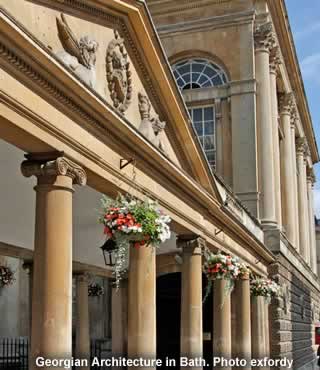Georgian Architecture |
|
 |
|||
Britain > Introduction > Georgian Architecture |
A period of architecture that made a significant impression on the whole of Britain |
Listen to this article |
The Georgian period of British history begins with the reign of King George I in 1714, and ends with George IV's death in 1830. During this time, it was common for members of the aristocracy to take extended trips throughout Europe. This meant that an entire generation of architects were extremely familiar with continental design. This influence manifested itself strongly in the building styles of the 18th century. |
The best place in the country to see Georgian architecture like this is the city of Bath. The settlement had become a popular spa town, and the upper classes visited in their hundreds. There was a huge demand for fashionable buildings to accommodate these well-to-do visitors. |
The first architect to begin meeting this demand was John Wood. He had a prolific career, designing dozens of houses, squares and streets. His work was based on simple decoration and frequent repetition. The best and most celebrated examples of this style are his terraced houses. They usually featured rows of identical façades, making them look like huge mansions. |
Wood's first project was Queen Square, where he happened to live at the time. As with much of his subsequent work, the Square has become a Grade I listed structure. In the following years, Wood went on to design the North and South Parades, St. John's Hospital, and Prior Park Mansion. |
In the 1750s he began work on what would become his masterpiece. This was "The Circus", another terrace of houses. This time though, they were arranged in an unorthodox circular formation. The effect would prove to be stunning but, unfortunately, John Wood didn't live to see its completion. He died in 1754, leaving the work to his son, John Wood the Younger. Thankfully the son very much followed in his father's footsteps, and he made sure The Circus was finished. |
Soon afterwards, John Wood the Younger made his own mark on the city. He expanded on his father's distinct style, and created what is now known as the greatest piece of Georgian architecture in Bath. This is the Royal Crescent, a sweeping curve of houses at the head of a wide, green lawn. Wood went on to design several other buildings, such as the Assembly Rooms, but the Crescent is certainly the cream of the crop. |
A large proportion of Bath's Georgian buildings were created by the Elder and Younger John Wood duo, but they weren't the only architects in town. John Palmer was responsible for Lansdown Crescent, a similar curved terrace just to the north of Wood's classic work. In 1770, Robert Adam created the Pulteney Bridge by adapting an unused design from Venice. It's one of only two bridges in Europe to support a shopping arcade. |
In 1775, a man called Thomas Baldwin was appointed as the Bath City Architect. He made a significant contribution to the city, designing such structures as the Guildhall and the Pump Room. He was later fired from his post for financial irregularities, but that shouldn't detract from any appreciation of his work! |
The Georgians made a significant impression on the whole of Britain, but no settlement was affected as strongly as Bath. The city was transformed from an insignificant little town into what is arguably the prettiest settlement in the country. |
|
Pocket Britain is optimised for use on a smartphone or tablet with internet access. All content is subject to copyright. All reasonable methods have been used to ensure information supplied is accurate at the time of publication. However, it is advisable to check information before relying on it. Privacy Policy |